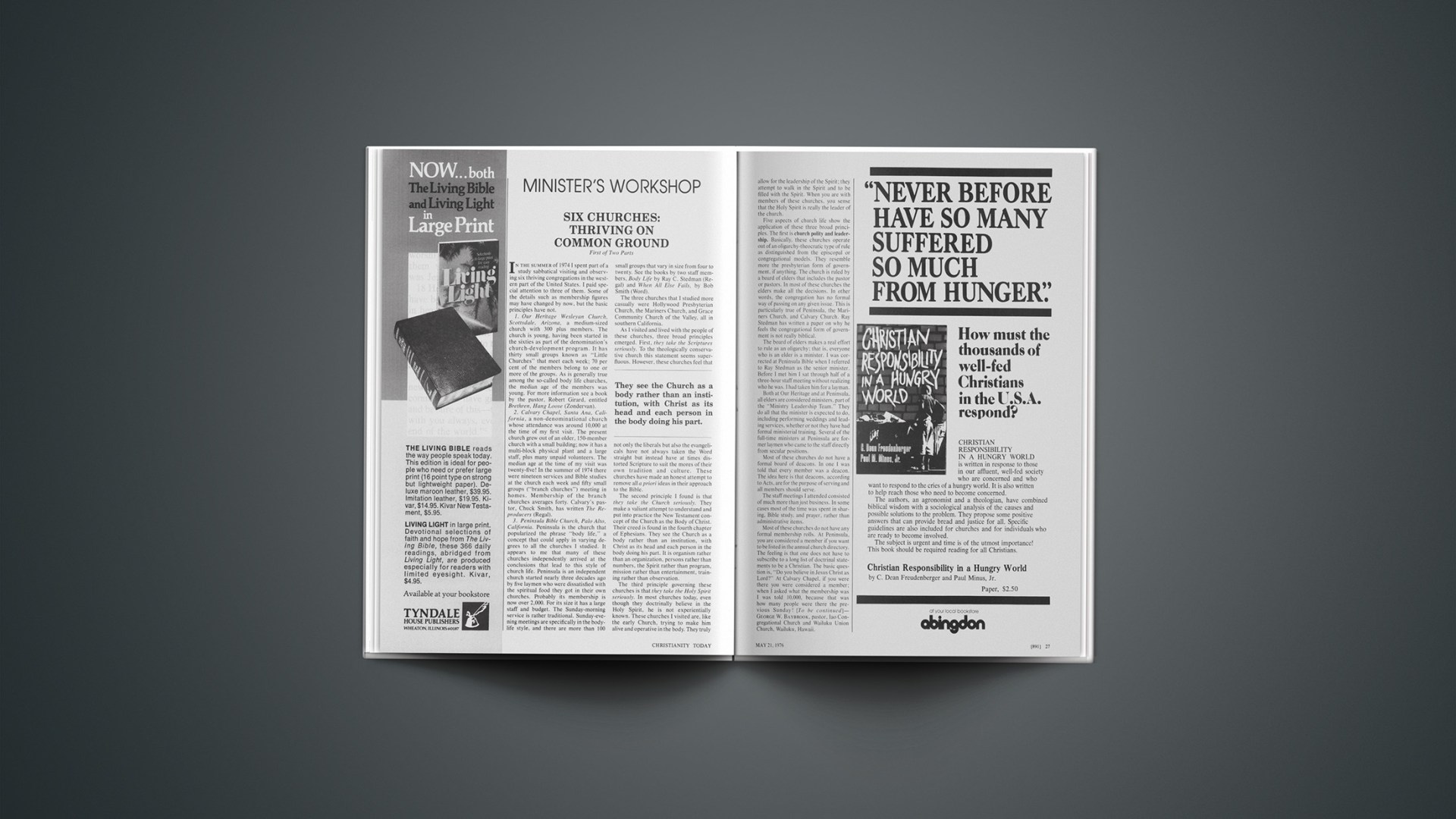In the summer of 1974 I spent part of a study sabbatical visiting and observing six thriving congregations in the western part of the United States. I paid special attention to three of them. Some of the details such as membership figures may have changed by now, but the basic principles have not.
I. Our Heritage Wesleyan Church, Scottsdale, Arizona, a medium-sized church with 300 plus members. The church is young, having been started in the sixties as part of the denomination’s church-development program. It has thirty small groups known as “Little Churches” that meet each week; 70 per cent of the members belong to one or more of the groups. As is generally true among the so-called body life churches, the median age of the members was young. For more information see a book by the pastor, Robert Girard, entitled Brethren, Hang Loose (Zondervan).
2. Calvary Chapel, Santa Ana, California, a non-denominational church whose attendance was around 10,000 at the time of my first visit. The present church grew out of an older, 150-member church with a small building; now it has a multi-block physical plant and a large staff, plus many unpaid volunteers. The median age at the time of my visit was twenty-five! In the summer of 1974 there were nineteen services and Bible studies at the church each week and fifty small groups (“branch churches”) meeting in homes. Membership of the branch churches averages forty. Calvary’s pastor, Chuck Smith, has written The Reproducers (Regal).
3. Peninsula Bible Church, Palo Alto, California. Peninsula is the church that popularized the phrase “body life,” a concept that could apply in varying degrees to all the churches I studied. It appears to me that many of these churches independently arrived at the conclusions that lead to this style of church life. Peninsula is an independent church started nearly three decades ago by five laymen who were dissatisfied with the spiritual food they got in their own churches. Probably its membership is now over 2,000. For its size it has a large staff and budget. The Sunday-morning service is rather traditional. Sunday-evening meetings are specifically in the body-life style, and there are more than 100 small groups that vary in size from four to twenty. See the books by two staff members, Body Life by Ray C. Stedman (Regal) and When All Else Fails, by Bob Smith (Word).
The three churches that I studied more casually were Hollywood Presbyterian Church, the Mariners Church, and Grace Community Church of the Valley, all in southern California.
As I visited and lived with the people of these churches, three broad principles emerged. First, they take the Scriptures seriously. To the theologically conservative church this statement seems superfluous. However, these churches feel that not only the liberals but also the evangelicals have not always taken the Word straight but instead have at times distorted Scripture to suit the mores of their own tradition and culture. These churches have made an honest attempt to remove all a priori ideas in their approach to the Bible.
The second principle I found is that they take the Church seriously. They make a valiant attempt to understand and put into practice the New Testament concept of the Church as the Body of Christ. Their creed is found in the fourth chapter of Ephesians. They see the Church as a body rather than an institution, with Christ as its head and each person in the body doing his part. It is organism rather than an organization, persons rather than numbers, the Spirit rather than program, mission rather than entertainment, training rather than observation.
The third principle governing these churches is that they take the Holy Spirit seriously. In most churches today, even though they doctrinally believe in the Holy Spirit, he is not experientially known. These churches I visited are, like the early Church, trying to make him alive and operative in the body. They truly allow for the leadership of the Spirit; they attempt to walk in the Spirit and to be filled with the Spirit. When you are with members of these churches, you sense that the Holy Spirit is really the leader of the church.
Five aspects of church life show the application of these three broad principles. The first is church polity and leadership. Basically, these churches operate out of an oligarchy-theocratic type of rule as distinguished from the episcopal or congregational models. They resemble more the presbyterian form of government, if anything. The church is ruled by a board of elders that includes the pastor or pastors. In most of these churches the elders make all the decisions. In other words, the congregation has no formal way of passing on any given issue. This is particularly true of Peninsula, the Mariners Church, and Calvary Church. Ray Stedman has written a paper on why he feels the congregational form of government is not really biblical.
The board of elders makes a real effort to rule as an oligarchy; that is, everyone who is an elder is a minister. I was corrected at Peninsula Bible when I referred to Ray Stedman as the senior minister. Before I met him I sat through half of a three-hour staff meeting without realizing who he was. I had taken him for a layman.
Both at Our Heritage and at Peninsula, all elders are considered ministers, part of the “Ministry Leadership Team.” They do all that the minister is expected to do, including performing weddings and leading services, whether or not they have had formal ministerial training. Several of the full-time ministers at Peninsula are former laymen who came to the staff directly from secular positions.
Most of these churches do not have a formal board of deacons. In one I was told that every member was a deacon. The idea here is that deacons, according to Acts, are for the purpose of serving and all members should serve.
The staff meetings I attended consisted of much more than just business. In some cases most of the time was spent in sharing, Bible study, and prayer, rather than administrative items.
Most of these churches do not have any formal membership rolls. At Peninsula, you are considered a member if you want to be listed in the annual church directory. The feeling is that one does not have to subscribe to a long list of doctrinal statements to be a Christian. The basic question is, “Do you believe in Jesus Christ as Lord?” At Calvary Chapel, if you were there you were considered a member; when I asked what the membership was I was told 10,000, because that was how many people were there the previous Sunday! —GEORGE W. BAYBROOK, pastor, Iao Congregational Church and Wailuku Union Church, Wailuku, Hawaii.










